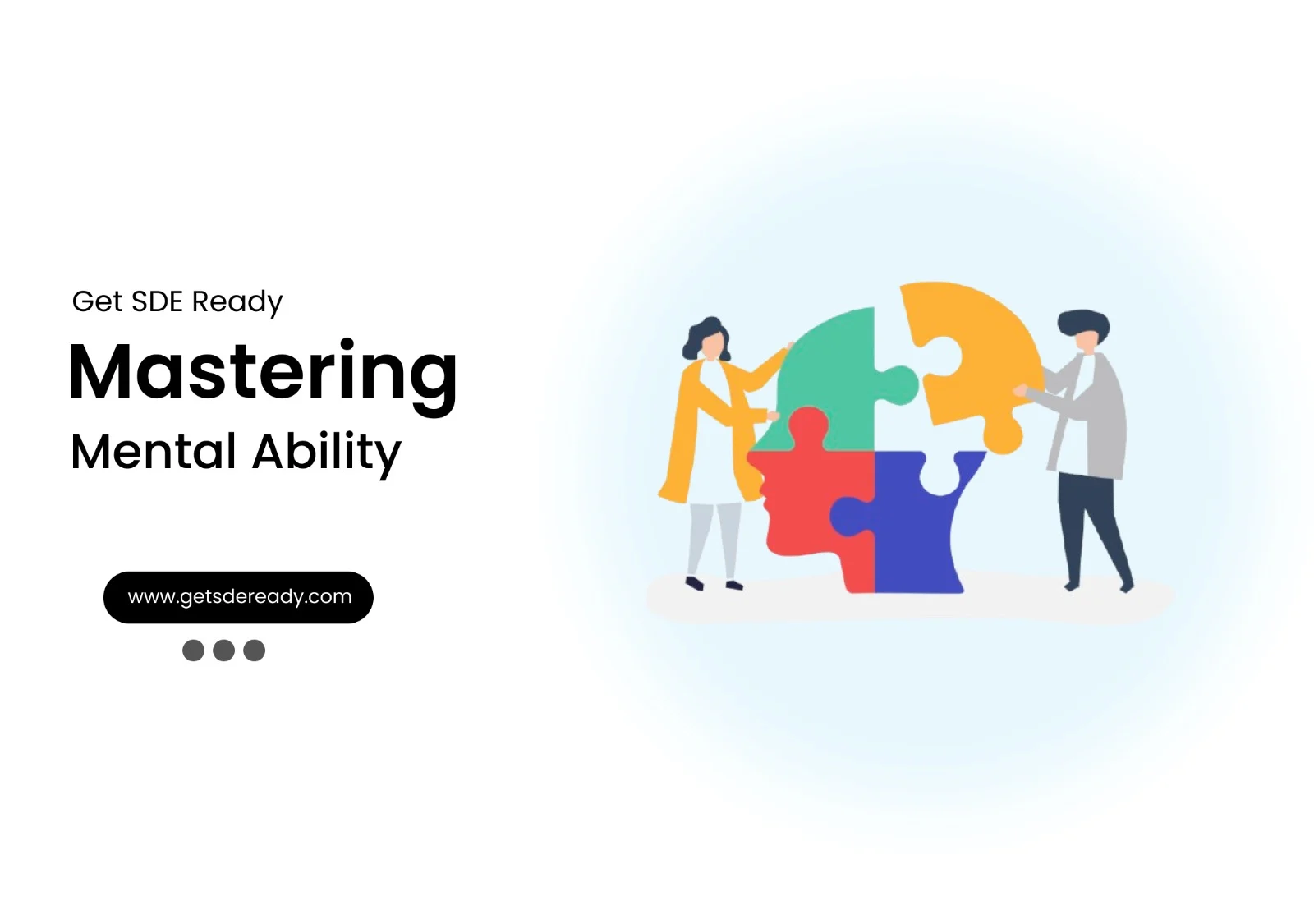Introduction to High-Level System Design
System Design Fundamentals
- Functional vs. Non-Functional Requirements
- Scalability, Availability, and Reliability
- Latency and Throughput Considerations
- Load Balancing Strategies
Architectural Patterns
- Monolithic vs. Microservices Architecture
- Layered Architecture
- Event-Driven Architecture
- Serverless Architecture
- Model-View-Controller (MVC) Pattern
- CQRS (Command Query Responsibility Segregation)
Scaling Strategies
- Vertical Scaling vs. Horizontal Scaling
- Sharding and Partitioning
- Data Replication and Consistency Models
- Load Balancing Strategies
- CDN and Edge Computing
Database Design in HLD
- SQL vs. NoSQL Databases
- CAP Theorem and its Impact on System Design
- Database Indexing and Query Optimization
- Database Sharding and Partitioning
- Replication Strategies
API Design and Communication
Caching Strategies
- Types of Caching
- Cache Invalidation Strategies
- Redis vs. Memcached
- Cache-Aside, Write-Through, and Write-Behind Strategies
Message Queues and Event-Driven Systems
- Kafka vs. RabbitMQ vs. SQS
- Pub-Sub vs. Point-to-Point Messaging
- Handling Asynchronous Workloads
- Eventual Consistency in Distributed Systems
Security in System Design
Observability and Monitoring
- Logging Strategies (ELK Stack, Prometheus, Grafana)
- API Security Best Practices
- Secure Data Storage and Access Control
- DDoS Protection and Rate Limiting
Real-World System Design Case Studies
- Distributed locking (Locking and its Types)
- Memory leaks and Out of memory issues
- HLD of YouTube
- HLD of WhatsApp
System Design Interview Questions
- Adobe System Design Interview Questions
- Top Atlassian System Design Interview Questions
- Top Amazon System Design Interview Questions
- Top Microsoft System Design Interview Questions
- Top Meta (Facebook) System Design Interview Questions
- Top Netflix System Design Interview Questions
- Top Uber System Design Interview Questions
- Top Google System Design Interview Questions
- Top Apple System Design Interview Questions
- Top Airbnb System Design Interview Questions
- Top 10 System Design Interview Questions
- Mobile App System Design Interview Questions
- Top 20 Stripe System Design Interview Questions
- Top Shopify System Design Interview Questions
- Top 20 System Design Interview Questions
- Top Advanced System Design Questions
- Most-Frequented System Design Questions in Big Tech Interviews
- What Interviewers Look for in System Design Questions
- Critical System Design Questions to Crack Any Tech Interview
- Top 20 API Design Questions for System Design Interviews
- Top 10 Steps to Create a System Design Portfolio for Developers
Introduction to High-Level System Design
System Design Fundamentals
- Functional vs. Non-Functional Requirements
- Scalability, Availability, and Reliability
- Latency and Throughput Considerations
- Load Balancing Strategies
Architectural Patterns
- Monolithic vs. Microservices Architecture
- Layered Architecture
- Event-Driven Architecture
- Serverless Architecture
- Model-View-Controller (MVC) Pattern
- CQRS (Command Query Responsibility Segregation)
Scaling Strategies
- Vertical Scaling vs. Horizontal Scaling
- Sharding and Partitioning
- Data Replication and Consistency Models
- Load Balancing Strategies
- CDN and Edge Computing
Database Design in HLD
- SQL vs. NoSQL Databases
- CAP Theorem and its Impact on System Design
- Database Indexing and Query Optimization
- Database Sharding and Partitioning
- Replication Strategies
API Design and Communication
Caching Strategies
- Types of Caching
- Cache Invalidation Strategies
- Redis vs. Memcached
- Cache-Aside, Write-Through, and Write-Behind Strategies
Message Queues and Event-Driven Systems
- Kafka vs. RabbitMQ vs. SQS
- Pub-Sub vs. Point-to-Point Messaging
- Handling Asynchronous Workloads
- Eventual Consistency in Distributed Systems
Security in System Design
Observability and Monitoring
- Logging Strategies (ELK Stack, Prometheus, Grafana)
- API Security Best Practices
- Secure Data Storage and Access Control
- DDoS Protection and Rate Limiting
Real-World System Design Case Studies
- Distributed locking (Locking and its Types)
- Memory leaks and Out of memory issues
- HLD of YouTube
- HLD of WhatsApp
System Design Interview Questions
- Adobe System Design Interview Questions
- Top Atlassian System Design Interview Questions
- Top Amazon System Design Interview Questions
- Top Microsoft System Design Interview Questions
- Top Meta (Facebook) System Design Interview Questions
- Top Netflix System Design Interview Questions
- Top Uber System Design Interview Questions
- Top Google System Design Interview Questions
- Top Apple System Design Interview Questions
- Top Airbnb System Design Interview Questions
- Top 10 System Design Interview Questions
- Mobile App System Design Interview Questions
- Top 20 Stripe System Design Interview Questions
- Top Shopify System Design Interview Questions
- Top 20 System Design Interview Questions
- Top Advanced System Design Questions
- Most-Frequented System Design Questions in Big Tech Interviews
- What Interviewers Look for in System Design Questions
- Critical System Design Questions to Crack Any Tech Interview
- Top 20 API Design Questions for System Design Interviews
- Top 10 Steps to Create a System Design Portfolio for Developers
Dropbox System Design: Scalable Cloud File Storage Architecture
Introduction: What Is Dropbox Storage Architecture?
Dropbox is a cloud file storage service that provides secure, reliable access to files from any device. Whether you’re on a laptop, smartphone, or public computer, your data is always within reach. But how do you design a scalable cloud storage system that supports millions of users and billions of files? If you’re new to distributed systems, begin with our cloud computing crash course to build foundational knowledge.
Why Scalability and Performance Matter
Designing a file storage service at Dropbox scale isn’t just “save and retrieve.” You must balance:
- High throughput for uploads/downloads
- Global availability across data centers
- Data consistency vs. latency under the CAP theorem
- Security and end‑to‑end encryption
This guide covers both functional requirements (core features) and non‑functional requirements (performance, reliability, security), walking through entity modeling, API design, chunked uploads, CDN integration, and real‑time file synchronization.
Functional Requirements: Core Features Every Cloud Storage Needs
- Upload from Any Device: Support laptops, mobile, tablets
- Download on Demand: Fast, presigned URLs for secure delivery
- File Sharing and Permissions: Grant view or edit access
- Automatic Sync: Instant mirroring across all devices
These features must work on variable networks (fiber to spotty mobile) and for file sizes ranging from 2 KB to 50 GB.
Non‑Functional Requirements: Ensuring Reliability and Security
- High Availability
- Large File Support (up to 50 GB)
- Performance (parallel chunk transfers, low latency)
- End‑to‑End Encryption
- Data Recovery for accidental deletes
Prioritizing availability over strict consistency (AP in CAP) allows uploads in Berlin to appear in New York within seconds rather than blocking both.
Core Entities and Metadata Schema
Primary Entities
- File: Raw byte content
- FileMetadata: Name, size, MIME type, owner, timestamps
- User: Account details and credentials
FileMetadata Schema
{
"id": "a1b2c3d4-e5f6-7890-g1h2-i3j4k5l6m7n8",
"name": "company_retreat_video.mp4",
"size": 5368709120,
"mimeType": "video/mp4",
"uploadedBy": "user123",
"createdAt": "2025-03-04T09:12:45Z",
"updatedAt": "2025-03-04T09:45:22Z",
"status": "uploading",
"fingerprint": "1a2b3c4d5e6f7g8h",
"chunks": [
{
"id": "chunk-0000",
"size": 10485760,
"status": "uploaded",
"fingerprint": "aa1bb2cc3dd4"
}
// Additional chunks…
]
}
Learn best practices for metadata modeling in our Data Science curriculum.
API Design: Building Blocks of Your Service
Upload Process
Initiate an Upload
POST /files
{
"name": "vacation_photos.zip",
"size": 1572864000,
"mimeType": "application/zip",
"fingerprint": "5a8d7c9b6f3e2d1a",
"chunks": 150
}
Response: File ID and presigned URLs per chunk.
Check Upload Status
GET /files/{fileId}/status → { "status": "uploading", "completedChunks": 75, "totalChunks": 150 }
Complete Upload
POST /files/{fileId}/complete → { "status": "uploaded", "url": "/files/{fileId}" }
Download Process
Get Download URL
GET /files/{fileId}/download
{
"url": "https://cdn.example.com/f8d7c9b6…?token=xyz789",
"expiresAt": "2025-03-05T15:30:00Z"
}
Sharing APIs
Share a File
POST /files/{fileId}/share
{
"users": ["user456", "user789"],
"accessLevel": "view"
}
Response: Success flag and sharedWith list.
Sync APIs
Get Changes
GET /files/changes?since={timestamp}
WebSocket Connection
GET /sync/connect for real‑time notifications.
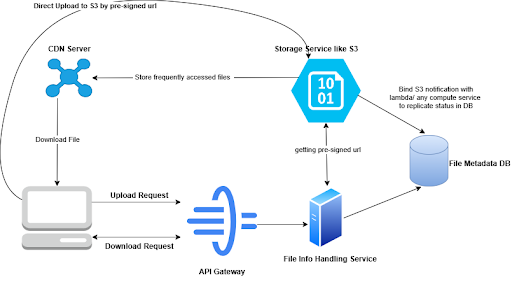
File Upload Process: Chunked and Resumable
- Fingerprinting: Compute SHA‑256 on full file and on each chunk.
- Chunk Splitting: 5–10 MB pieces enable parallelism and resumability.
- Presigned Upload: Client uses S3‑style presigned URLs to upload chunks directly to blob storage.
- Compose: On completion, trigger server‑side assembly of chunks.
Pro tip: Review our Master DSA, Web Dev & System Design program to deepen your understanding of fingerprinting algorithms and multipart upload patterns.
File Download: CDN‑Optimized Delivery
- Presigned URLs point to CDN endpoints
- Edge Caching reduces latency by serving files from nearest PoP
- Byte‑Range Requests support resumable and streaming downloads
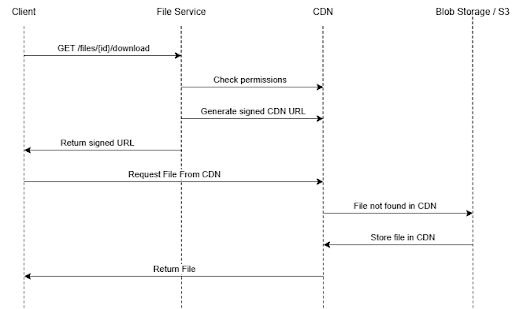
Brush up on CDN integration strategies in our Web Development courses.
File Sharing: Normalized Schema for Efficiency
Use a SharedFiles table rather than embedding share lists:
UserId | FileId | SharedBy | Timestamp | AccessLevel |
userA | f8d7…1 | userA | 2025-02-28T15:30Z | view |
userA | f8d7…2 | userA | 2025-02-28T15:30Z | edit |
This enables fast queries like “What files have been shared with me?” without scanning all FileMetadata records.
Real‑Time Sync: Local ↔ Remote Architecture
Local → Remote
- Filesystem Events: inotify, FSEvents, FileSystemWatcher
- Delta Detection: Upload only changed chunks
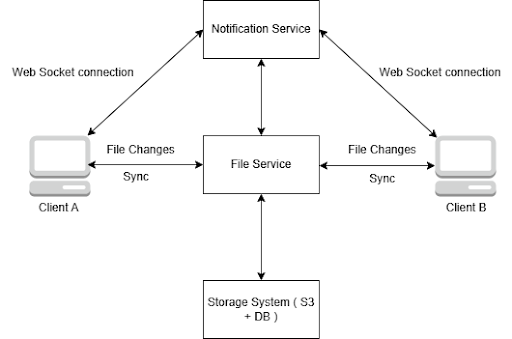
Remote → Local
- WebSockets push change notifications
- Fallback Polling for reliability
- Conflict Resolution: Last-write-wins and conflict‑copy creation
For deeper insights into distributed synchronization, explore our Essential DSA & Web Dev Courses for Programmers.
Supporting Large Files: Overcoming Size Limits
- Timeout Mitigation: At 10 Mbps, 50 GB ≈ 11 hours; chunking reduces this risk.
- Browser Constraints: Split into <4 GB requests to avoid HTTP limits.
- Resume Logic: Client asks server “Which chunks are missing?” by fingerprint query.
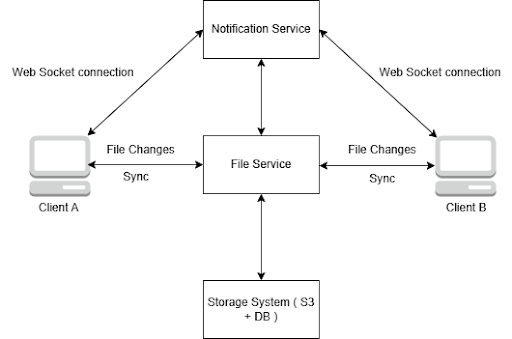
Performance Optimizations: Maximizing Throughput
- CDN Edge Servers: Global distribution for low-latency downloads.
- Parallel Transfers: 6–8 concurrent connections per domain.
- Adaptive Bandwidth: Dynamically adjust parallelism based on network conditions.
- File Compression: Apply to text and document formats when beneficial.
Test your algorithmic skills with our Top Amazon DSA Interview Prep Guide and Top 20 DSA Interview Questions You Need to Know.
System Architecture: Putting It All Together
- Clients: Web, Mobile, Desktop Sync
- Frontend Services: Authentication, API Gateway, Web Servers
- Backend Services: File Service, Notification Service
- Storage: NoSQL Metadata, Blob Storage, Cache Layer
- Infrastructure: Load Balancers, Monitoring, Analytics, CDN
Conclusion: Building for Scalability and Trustworthiness
A Dropbox‑like system blends chunking, metadata management, and real‑time sync into a seamless user experience. By favoring availability, leveraging CDNs, and implementing robust conflict resolution, you create a reliable, secure, and high‑performance cloud storage service. If you’re ready to advance your skills in system design and algorithms, check out our Top Meta Facebook DSA Interview Questions and dive into our complete DSA course lineup.

DSA, High & Low Level System Designs
- 85+ Live Classes & Recordings
- 24*7 Live Doubt Support
- 400+ DSA Practice Questions
- Comprehensive Notes
- HackerRank Tests & Quizzes
- Topic-wise Quizzes
- Case Studies
- Access to Global Peer Community
Buy for 52% OFF
₹25,000.00 ₹11,999.00
Accelerate your Path to a Product based Career
Boost your career or get hired at top product-based companies by joining our expertly crafted courses. Gain practical skills and real-world knowledge to help you succeed.

SDE 360: Master DSA, System Design, AI & Behavioural
- 100+ Live Classes & Recordings
- 24*7 Live Doubt Support
- 400+ DSA Practice Questions
- Comprehensive Notes
- HackerRank Tests & Quizzes
- Topic-wise Quizzes
- Case Studies
- Access to Global Peer Community
Buy for 50% OFF
₹39,999.00 ₹19,999.00

DSA, High & Low Level System Designs
- 85+ Live Classes & Recordings
- 24*7 Live Doubt Support
- 400+ DSA Practice Questions
- Comprehensive Notes
- HackerRank Tests & Quizzes
- Topic-wise Quizzes
- Case Studies
- Access to Global Peer Community
Buy for 52% OFF
₹25,000.00 ₹11,999.00

Fast-Track to Full Spectrum Software Engineering
- 120+ Live Classes & Recordings
- 24*7 Live Doubt Support
- 400+ DSA Practice Questions
- Comprehensive Notes
- HackerRank Tests & Quizzes
- 12+ live Projects & Deployments
- Case Studies
- Access to Global Peer Community
Buy for 51% OFF
₹35,000.00 ₹16,999.00
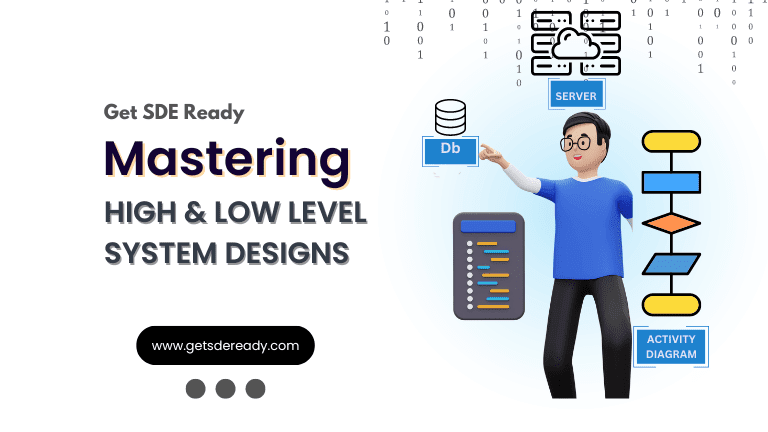
Low & High Level System Design
- 20+ Live Classes & Recordings
- 24*7 Live Doubt Support
- Case Studies
- Comprehensive Notes
- HackerRank Tests
- Topic-wise Quizzes
- Access to Global Peer Community
- Interview Prep Material
Buy for 60% OFF
₹20,000.00 ₹7,999.00
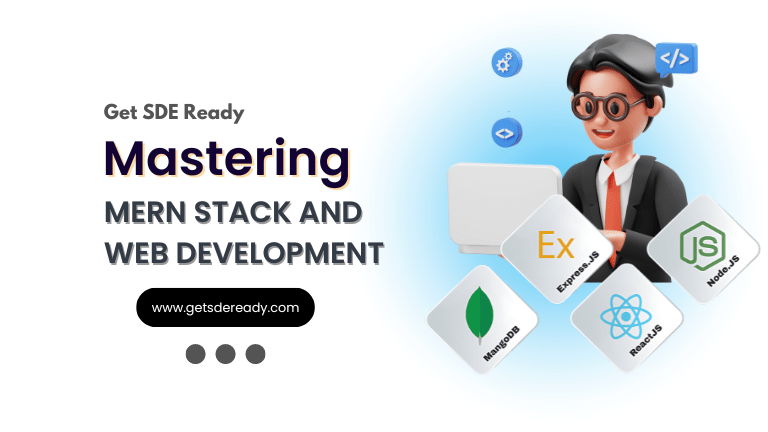
Mastering Mern Stack (WEB DEVELOPMENT)
- 65+ Live Classes & Recordings
- 24*7 Live Doubt Support
- 12+ Hands-on Live Projects & Deployments
- Comprehensive Notes & Quizzes
- Real-world Tools & Technologies
- Access to Global Peer Community
- Interview Prep Material
- Placement Assistance
Buy for 53% OFF
₹15,000.00 ₹6,999.00
Reach Out Now
If you have any queries, please fill out this form. We will surely reach out to you.
Contact Email
Reach us at the following email address.
arun@getsdeready.com
Phone Number
You can reach us by phone as well.
+91-97737 28034
Our Location
Rohini, Sector-3, Delhi-110085

